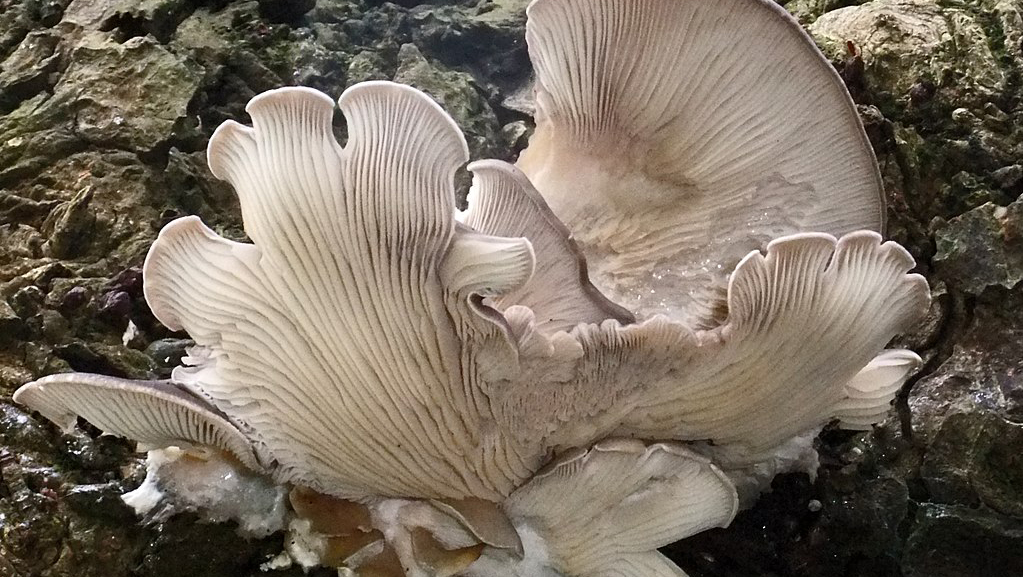
In 2014, scientists discovered that oyster mushrooms grown in a substrate of used diapers and lignin can break down cellulose found in the diapers for food, which reduces the diapers' weight and volume by up to 80%. (Martin Cooper/Creative Commons)

In 2014, scientists discovered that oyster mushrooms grown in a substrate of used diapers and lignin can break down cellulose found in the diapers for food, which reduces the diapers' weight and volume by up to 80%. (Martin Cooper/Creative Commons)
In a state of perfect nature, there is no such thing as waste.
Every product of every organic process — from a butterfly breaking free of its cocoon to grizzly sows, rooting for grubs in the dirt — is crucial to the continued vital functioning of its larger ecosystem. In usurping that delicate play of interactions to further its own ends, mankind has disrupted the balance of nature.
The price of such folly stands readily apparent; litter-strewn streets, plastic-clogged beaches, the Great Pacific Garbage Patch. Mountains of rancid, steaming trash that can’t be redeemed, and thus must be contained until they rot away – which, in the case of most modern synthetic materials, won’t happen for hundreds of years.
However, all is not lost. Over these last two decades, increased awareness of powers that certain species possess has opened the scientific consciousness to new possibilities for treating some synthetic wastes.
Take diapers. Because they’re made up of mostly synthetic materials, each one lasts centuries in a landfill. The amount of disposable diapers babies go through during infancy (8000), plus the projected population growth of several countries over the next 50 years (positive), is fairly easy math to do: it adds up several thousand tons of soiled garment waste per year.
But there is a solution.
Disposable diapers contain a plant material called cellulose. In 2014, scientists in Mexico City discovered that oyster mushrooms grown in a substrate of used diapers and lignin can break down that cellulose for food, which reduces the diapers’ weight and volume by up to 80%. What’s left over is mostly recyclable plastics and non-biodegradable, superabsorbent gel, which has potential agricultural applications for areas stricken by drought. The mushrooms can be sold off for animal feed and fertilizer. And it doesn’t have to stop there – if the process works for diapers, then it stands to reason it should work for other types of sanitary waste, like tampons and maxi-pads.
Or what about plastic? Researchers at the Netherlands’ Utrecht University devised a way to turn it into food. By introducing sugar and starch to an agar container filled with UV-treated polyethylene, two commonly cultivated and edible mushroom species — Schizophyllum commune and Pleurotus ostreatus — can be coaxed to grow inside it. The mycelium — the web-like ‘root’ of the fungus — breaks down and metabolizes plastic waste in only a few weeks. What’s left over is edible biomass: possibly a new food source for Earth’s ever-growing population.
And that’s not nearly all. Mealworms, it turns out, can metabolize Styrofoam; they have a microbe in their gut that breaks down polystyrene, which the worms excrete as compost. The bacteria Ideonella sakaiensis is especially adept at eating plastic water bottles and peanut butter jars.
Pseudomonas putida is another important bacterium. It has the ability to live on pure styrene oil; basically, melted Styrofoam.
There is a veritable treasure-trove of bio-chemical gold to be found in some of our planet’s most overlooked species. It remains only to develop methods we might harvest and refine it. The person who discovers a method, or methods, by which that might be done — who manages to extract and concentrate the plastic-degrading enzymes in wax-worm entrails; who isolates the process by which Pestalotiopsis microspora, a rare mushroom from the Amazon, breaks down polyurethane; who genetically engineers a bacterium that can digest all different kinds of plastics; who is able to bring the Fungi Mutarium into viable, large-scale use — that person stands not only to gain wealth beyond man’s wildest dreams but go down in the annals of human history a hero.